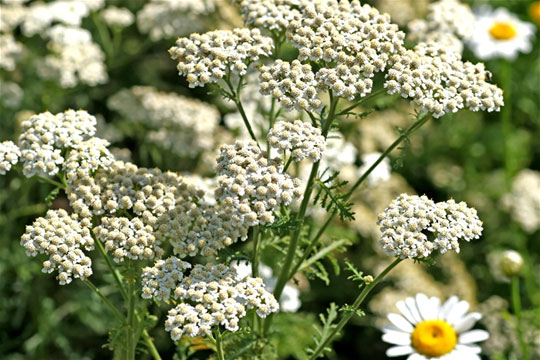
Achillea millefolium or common yarrow
“Millefolium” literally means a thousand leaves and it is said that its name, Achillea, is derived from Achilles the Greek hero of the Trojan wars. Myth has that it was given to him by a Greek God to carry into battle to help treat battle wounds.
The herb has been used according to experts for over 3,000 years, and was first used on the battlefield to treat wounds, primarily to stop the flow of blood.
Yarrow is considered an herb, and is grown for medicinal purposes in many parts of the world. However, it is also commonly grown in gardens, in particular butterfly gardens as an ornamental plant. It can be found growing wild in ditches, on hillsides and in meadows. It can literally grow anywhere and it especially likes rocks, so it is perfect for rock gardens, and rocky hillsides.
In ancient times, yarrow was known as herbal militaris.
Yarrow is native to temperate regions in the Northern Hemisphere, throughout Asia, Europe and North America. Yarrow is a perennial plant that can grow up to three feet tall. Yarrow will grow at sea level up to over 11,000 feet so virtually anyone anywhere, can cultivate this plant.
Parts of the Plant Used (Best Collected When the Flower is In Bloom)
- Flowers
- Leaves
- Stems
Uses
Yarrow can be ingested raw, used in foods such as salads or brewed as a tea. Use it to staunch the flow of blood by applying directly to the wound. This according to some is the first known medical use of the yarrow plant.
You can use it to reduce inflammation in the digestive track and use to relieve toothache pain by chewing the raw leaves. It is said to have antibacterial properties, so not only does it stop the flow of blood it can also help prevent infections in wounds and may kill bacteria in the mouth as it is chewed.
Native Americans infused the yarrow leaves and poured it into ears to relieve/cure ear infections. They also inhaled the vapors from the steaming tea to relieve headache pain. Steep the leaves or other parts to make tea to help with anxiety and insomnia.
Use yarrow tea to treat urinary track infections and it is even used to treat incontinence. Doctors in the past were known to prescribe yarrow tea for “those that cannot hold their water”.
The plant induces sweating so it is used to help break a fever. Sweating of course will cool the body. If used for fevers make sure the patient is well hydrated before treatment. Yarrow is often times used to treat colds. When treating for colds adding peppermint to yarrow tea will help open up sinus cavities. Steep the leaves and peppermint to make a hot brew, drink while still hot, and inhale the vapors as you drink.
Yarrow according to most experts raises body heat, which promotes sweating. Doctors prescribing yarrow in the past have stated it allows the skin to give off heat thus reducing fevers in the body’s organs. The anti-inflammatory properties of the plant are said to relax blood vessels allowing for better circulation. Pores will open wider allowing for more productive sweating, and the release of toxins from the body.
Yarrow because it is used for better circulation, can help reduce blood pressure. The full benefits of yarrow are still somewhat of a mystery, so this means a host of aliments can be treated, aliments that you may have and are not aware of yet. Use yarrow as a preventative, by taking regularly regardless of your current state of health.
Experts in the past and even some today, state that yarrow can be used to treat all organs in the body, and its full potential is not yet known.
Yarrow is said to increase bile production, which is necessary for good digestion and is used regularly to treat a wide range of stomach and intestinal problems.
The essential oils from the plant can also be used to treat minor skin infections/irritations. It can be used for full body bathing by adding to the bath water. Crush/bruise the leaves and stems to ensure the essential oils are released into the water.
Entire books have been written about the benefits of yarrow so its benefits are literally too many to mention here.
Note: The information provided is informational only and should not be considered or construed as medical advice. Check with your health care provider before taking any herbal medications not specifically prescribed by a medical professional. This is especially true of any one that is, or may be, pregnant or is nursing.
Growing Yarrow
You can purchase yarrow seeds and sow in the garden after the threat of frost has passed in the spring or start the seeds indoors six to eight weeks before the last frost then transplant in the garden. If started indoors harden the plants off by placing outside during the day, up to 10 days before transplanting.
You can also divide the plants in early spring or late fall and transplant in another location. Many people have had success finding the plant growing wild and splitting the roots to carry home for planting. Avoid destroying the wild plant to ensure it can continue to grow.
The plant prefers full sunlight, and being a hardy plant it requires little care once established. The plant does not require fertilizer to reach mature growth but if you do want to fertilize use compost.